TRASH AND GARBAGE IN JAPAN
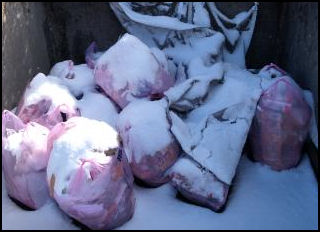
snow-covered trash
in special pink bags Japanese cities are very clean. Graffiti is hard to find and when it found it often has an upbeat message like “Find Your Dream.” It is not uncommon to see uniformed men down on his knees scrapping wads of gum off the pavement or policeman issuing tickets for smoking on the streets. On Sundays you can see groups of older Japanese men cleaning up neighborhoods. Some groups that clean up stuff belong to religious sects.
In the old days garbage was simply divided according to whether it was burnable or non-burnable. All one had to do was divide them and put them out on the correct collection day. In recent years, a typical area in Japan makes at least 12 distinctions between trash types — newspaper, cardboard, milk cartons, books and magazines, other "mixed" paper, rags, cans, bottles, PET bottles, other plastic, and then whatever doesn't fit into these categories is separated into burnable or non-burnable, with a few minor exceptions and additions. [Source: Kate Elwood, Daily Yomiuri]
Japanese generate garbage at a rate of about 1.1 kilograms per person per day.
Pounds of trash produced per person per year in municipalities of selected countries: 1) the United States (1,600 pounds); 2) Australia (1,500); 3) Canada (1,450); 4) Iceland (1,250); 5) Norway (1,150); 6) the Netherlands (1,250); 7) Luxembourg (1,100); 8) France (1,050); 9) Denmark (1,000); 10) Japan (875); 11) Belgium (800); 12) Switzerland (800); 13) Hungary (775); 14) (775); 15) Spain (700); 16) Italy (675); 17) Poland (650); 18) Portugal (625); 19) Greece (600); 20) Mexico (600). [Source: Organization for Economic Cooperation and Development]
Much of Japan’s trash is picked up in trash trucks that play marching music or a simple, repeated melody to let people know they are coming. The trash men often run as they work. People can lose face if their trash bags are not properly tied. In some places crows rip open trash bags that are not properly covered.
Even though the majority of hikers in Mt. Fuji are very careful not to litter, the sheer numbers of them cause heaps of rubbish to pill up around the trash cans. In response to criticism about the trash, regular crews clean up litter along the trails and eco-friendly toilets have been installed. Some of the more advanced ones cost $40,000 and incinerate the waste, leaving behind ash that is brought to the bottom of the mountain. There are also some biological toilets that use microbes to break down the waste but there capacity is limited.
Websites and Resources
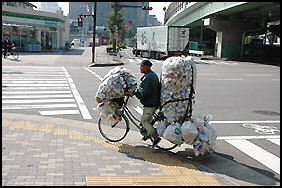
Links in this Website: GLOBAL WARMING, RAIN FORESTS AND JAPAN Factsanddetails.com/Japan ; ENVIRONMENTAL ISSUES AND POLLUTION IN JAPAN Factsanddetails.com/Japan ; RECYCLING AND ENVIRONMENTAL GROUPS IN JAPAN Factsanddetails.com/Japan ; OIL, COAL, NATURAL GAS AND ENERGY IN JAPAN Factsanddetails.com/Japan ; NUCLEAR ENERGY IN JAPAN Factsanddetails.com/Japan ; SOLAR, WIND AND ALTERNATIVE ENERGY IN JAPAN Factsanddetails.com/Japan ; NATURAL RESOURCES AND JAPAN Factsanddetails.com/Japan ; WATER IN JAPAN Factsanddetails.com/Japan
Good Websites and Sources on Recycling: 2005 New York Times Article on Recycling in Japan nytimes.com ; Yokohama City Recycling Instructions city.yokohama.jp/me/pcpb ; Good Photos at Japan-Photo Archive of Cleaning Jobs japan-photo.de and Junk Collectors japan-photo.de ;The Japan Containers and Packaging Recycling Association jcpra.or.jp ; Recycling Computers and Televisions Sony.net ; Paper on Recycling pdf file uwstout.edu
Environmental Groups List of Environmental Groups in Japan web-japan.org/links/society/ngo/environment ; Greenpeace in Japan greenpeace.or.jp ; Friends of the Earth Japan foejapan.org ; Japan’s Tropical Forest Action Network jca.apc.org/jatan ; Amazon Rainforest Foundation of Japan rainforestjp.com
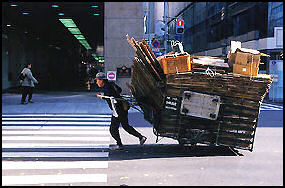
Good Websites and Sources on the Environment: Ministry of Environment env.go.jp/en ; National Institute for Environmental Studies nies.go.jp ; Quality of the Environment, a 2003 Report env.go.jp/policy/hakusyo ; Japan for Sustainability japanfs.org ; Japan Times Environment Page japantimes.co.jp ; Essay on Comparing Japan and Britain on Environmental Criteria aboutjapan.japansociety.org ; Wikipedia article on Environmental Issues in Japan Wikipedia ; NPR Story on Public Works and the Environment npr.org/templates/story ; Essay on Japan’s Forests and History aboutjapan.japansociety.org ; Statistics and Research Japan Environment Association jeas.or.jp ; Statistical Handbook of Japan Environment and Life Chapter stat.go.jp/english/data/handbook ; 2010 Edition stat.go.jp/english/data/nenkan ; News stat.go.jp Research Institute of Innovative Technology rite.or.jp ; Aozora.or Aozora.or ; Virtual Center for Environmental Technology Exchange apec-vc.or.jp ; Google E-Book: Japan in the 21st Century, Environment, Economy and Society (2005) books.google.com/books ;
Japanese Throwaway Society
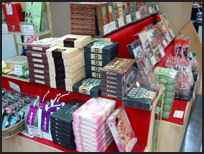
well-wrapped gifts Japan has been described as a throwaway society. Many products are sold with a lot of packaging. Shoppers are used to individually wrapped apples and pears. After French bread is purchases it is placed in three separate bags: one to keep it warm; another to separate it from other goods and a third to carry it home in.
Japanese give a lot of gifts, which often comes wrapped in layers and layers of fancy wrapping that ultimately have be thrown away. Plastic bottles and throwaway wooden chopsticks are favored over recyclable alternatives. Japanese use 25 billion pairs of disposable chopsticks every year.
Japanese also like to have the latest thing and after they get tired of it they throw it and get an even newer model. This principal even applies to houses which are expected to only last for 33 years, compared to 77 years in Britain, and be torn down and replaced with a new one. Japan relies so much on generating new products and carefully packing them to keep their economy going that there is a lot of resistance to certain aspects of the green movements because it will harm economic life and traditional ways of doing things.
The Japanese are also known for throwing out electronic items that still work and furniture that is still in good condition. A whole industry has grown up around claiming items that are regarded as valuable. Many of the items end up in foreign countries and many of the people who collect them are also foreigners, who sometimes ferry out work to homeless people. Old bicycles, refrigerators and washing machines often end up being shipped to North Korea.
Foreign Trash in Japan
Large amounts of foreign garbage mostly from China, Taiwan and South Korea, wash up on Japan’s shores on the Sea of Japan. The garbage includes pet bottles, cans, plastic bags, buoys and others stuff. Garbage from China increased 13-fold between the late 1990s and the late 2000s. But this countries can not be totally blames. On recent walk on a beach on the Sea of Japan most of what I saw, judging from the labels, was from Japan.
To address the problem of shoreline garbage the Japanese are not just cleaning up their beaches they are also constructing computer models to determine where ocean currents push open ocean garage and are developing schemes to collect it before it comes ashore.
Trash from Japan also finds it ways to other places. Discarded lighters and bottle caps from Japan, Korea and China that floated across the Pacific Ocean to the Midway Islands near Hawaii have been blamed for killing endangered Laysan albatross chicks that ingested the objects after being given them by their mothers who thought they were food. The young birds were unable to digest the plastic and were weakened as a result. Researchers who examined the dead chicks found 80 lighters with Chinese, Japanese and Korean writing inside them.
Trash and Garbage Disposal in Japan

old-style incinerator Japan has very little landfill space and people are opposed to incinerators placed near their homes. Fortunately the Japanese are excellent recyclers. Most of Japan's non-recyclable trash and garbage is disposed of in the country's 7,200 incinerators. Of the 450 million tons of household refuge produced annually in Japan, about 80 million tons is dumped in landfills and 370 million tons is burned in incinerators.
The NIMBY (Not in my Backyard) principles applies to incinerators in Japan. Most people don't want incinerators placed near their homes out of concerns over dioxin and other harmful chemicals they produce. According to one study in Osaka, people living near incinerators were three times more likely to come down with serious illnesses compared to people living in other areas.
Nippon Steel has developed a gasification melting technology that burns the refuge at 1700̊C, reducing dioxin levels to a forth of that produced by conventional incinerators.
Efforts to develop a garbage fuel have been less than successful, Potential users — private factories’say it so low in quality that the factories can’t even be paid to use it. In addition to that garbage fuel costs twice as much to make as simply incinerating it.
An issue that has become the focus of attention in Japan is disposal of industrial waste discharged by factories and businesses. The Waste Management and Public Cleansing Law of 1970 regulates the methods of disposal of certain wastes emitted by factories and businesses, such as soot, sludge, waste oil, and discarded plastic, plus other wastes. Industrial wastes in Japan amounted to 436.6 million tons in fiscal 2008, which is about eight times the volume of general waste from homes and offices. The Waste Management and Public Cleansing Law, as revised in June 1997, imposes stiff penalties on illegal waste disposal. The number of cases of illegal dumping has been declining, but the occurrence of several large-volume cases in fiscal 2003 and 2004 prompted the Ministry of the Environment to increase the number of staff assigned to waste and recycling monitoring. [Source: Web-Japan, Ministry of Foreign Affairs, Japan]
Recycling in Japan
The amount of general (non-industrial) waste generated in Japan has exceeded 50 million tons a year since 1990. This has increased the emphasis on recycling in Japan, which has one of the highest used paper recycling rates in the world. Garbage disposal sites are expected to reach their limit in a few years, and the burning of waste results in dioxin pollution, so recycling has become important as a solution for reducing the amount of trash. [Source: Web-Japan, Ministry of Foreign Affairs, Japan] Japan is one of the world's most efficient recycling nations. The ratio of used paper collected in Japan in 2010 was 78.3 percent of production volume, and the utilization rate (percentage of used paper reprocessed in paper manufacturing) was 62.5 percent, one of the highest used paper recycling rates in the world.The recycling rate is 99 percent for asphalt. The Japanese reuse over 50 percent of all household products, including 98 percent of their paper and 96 percent of their glass. To achieve this Japanese citizens are very good about followed rules set up my municipal governments outlined on a color-coded calendars that most people keep in their kitchens.
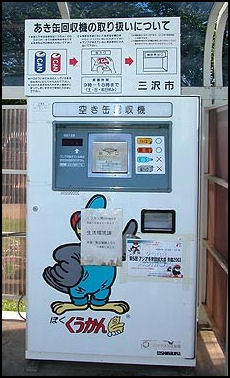
recycling machine
gives you money back Households in most places sort items in eight categories and place them outside for collection on the days specified on the calendar such as 2nd and 4th Fridays for newspapers, glass and cans and the 1st Friday for discarded furniture and other large items. Large items such as bicycles or televisions can be collected by paying a fee to local government pick up services or giving them to people that cruise in small trucks, using a loudspeaker to tick off the items they collect.
Recycling Methods and Innovations in Japan
In most places cans, bottles and newspapers are each placed in separate containers and picked up twice a month. Newspapers are also picked up by independent trash collectors who drive around in trucks and sometimes trade stacks of old newspaper for toilet paper. There are special collection days once a month for things like batteries, ceramics, old clothes, furniture, light bulbs, bicycles, televisions and other items. Supermarkets have receptacles for recycling milk cartons, plastic bottles, and Styrofoam trays.
In many places, trash has to be separated into burnable and nonburnable items. People that don't abide the rules have to deal with "trash lady," a local busy body who makes sure everyone toes the line. In some places, Japanese deposit their household trash and garbage in clear plastic bags with a tag with their name on it. The purpose of this is to humiliate people who place recyclable cans, bottles or newspapers in clear bag, which everyone who passes by can see.
Kyoto-based plasterer Hiroshi Murakami has developed a number of building materials made out of natural materials. Among these are earthquake-resistant wall panels made from pulped recycled paper, soil and lime-based hardener.
Toyota and other automobile makers are designing cars that are made almost completely of recyclable materials and designing systems to remove and process these materials. A law went into affect 2005 that requires car owners to pay a disposal fee when they get rid of their car and car makers are obliged to dispose of plastic, fabric waste, air bags, and CFCs from air conditioners. Other materials are taken care of by the scarp metal dealers.
Recycling Laws in Japan
The Fundamental Law for Establishing a Sound Material-Cycle Society was enacted in 2000 to serve as the basis for a comprehensive and systematic approach to waste and recycling. It was followed by a number of other new recycling laws covering specific areas such as home appliances, food waste, construction materials, automobiles, and personal computers.
On an international level, Japan proposed the “3R Initiative” at a G8 summit in 2004. Approved by the G8 nations, this initiative seeks to globally promote the 3Rs (reduce, reuse, and recycle) with the objectives of reducing the amount of waste created, reusing materials where possible, and then recycling them when they can’t be reused.
The implementation of the Receptacle Packaging Recycle Law in April 1997 placed the responsibility for recycling polyethylene terephthalate (PET) bottles, glass bottles, and paper and plastic packaging on the manufacturer. These receptacles comprise 20-30 percent of the total weight of general waste matter discarded by households, but, because of their bulk, they occupy 60 percent of the total volume. This law is based on dividing the cost of garbage disposal among companies, consumers, and municipalities, as compared to when disposal costs were formerly covered by taxes. When consumers discard a receptacle, they are required to presort it for the designated municipality pick-up areas, where it is collected for recycling by the manufacturers.
Beginning in April 2000, paper and plastic packaging will also be subject to recycling under this law. Electrical products discarded by Japanese households are almost all disposed of in landfills. The Specific Household Electrical Appliance Recycling Law was enacted in 1998 in an effort to reduce the volume of such landfill disposal.
Recycling Plastic, Platinum and Organic Materials in Japan
Japanese uses 30 billion plastic bags and collectively lose tens of thousands of plastic umbrellas every year.

There is a major push in Japan to get customers to reduce their use of plastics bags at stores and supermarkets. Some stores charge for plastic bags or give customers discounts if they bring their own bags. Others give out free reusable bags. Studies have shown that when customers are given bags for free nearly everybody takes them. When the bags the cost 4 cents only 30 percent take them. When they cost 8 cents only 8 percent take them.
Japan is one of the first countries to get into recyclable and biodegradable plastics in a big way. PET (polyethylene terephthalate resin) bottles are collected are turned into high-quality polyester or new bottles. Asahi Breweries has dressed some of its employees in uniforms made from recycled plastic bottles.
The price paid for used PET bottles rose 2.6-fold in the mid and late 2000s due to demand from Chinese companies for plastic materials. PET bottles are washed and crushed and sold to textile manufacturers. The recyclable resins they contain can be used in the production artificial fibers and plastic and demand for them has risen as the price of oil soared.
Tsukiji fish market in Tokyo produces 90 tons of waste a day, the equivalent of a city with 90,000 people. About 50 percent of the waste is in the form of paper, Styrofoam and cardboard boxes. These are placed in five-meter-high piles that are taken away to recycling centers in China who produce 50 millimeter granules that are sold to manufacturers of video tape, clothes hangers, combs, buckets and other objects. About 30 tons of tuna waste is created every day. Most of it is collected by a livestock feed maker that boils the waste, presses it into solid and liquid materials and separates oil from liquid with a centrifuge. The oil is used in margarine, soap and cosmetics. The solid waste is made into feed for chickens and farmed fish such as yellowtail.
Seldom-used metal pedestrian bridges on Osaka have been disassembled and shipped to Indonesia. Even the Shinkansen trains are recycled. The trains are first dismantled by heavy machinery and welders It takes about one day to take a car apart. The pieces are then shipped to a recycling contractors who sort out the pieces into aluminum, steel and non-iron metals. Any parts with value are sold. Others are crushed and sorted with machines. The reuse ratio for metal is 91 percent.
In June 2011, Aeon Co. — Japan’s largest supermarket chain and retailer — announced it use sugarcane based polyethylene plastic grocery bags at their outlets. The polyethylene is sourced from ethanol made from the waste liquid that is left over after extracting the sugar from sugarcane juice. The bags will be sold from all of their 750 supermarket stores at a cost of five yen apiece. Aeon has been selling in the neighborhood of 170 million plastic bags a year to their shoppers.
The Kobe-based company Kadokura has developed a technique for transforming felt from used clothes in a hard building material that can be sawed and hammered.
Recycling Plastic Bottles
In July 2011, the Yomiuri Shimbun reported: “Japanese firms have succeeded in developing a new system that recycles used PET bottles into high-quality material suitable for brand new bottles. Suntory Holdings Ltd. and Kyoei Industry Co., an Oyama, Tochigi Prefecture-based company that recycles, processes and sells plastic resin, said that the new production process can minimize the quantity of petroleum used and also cut carbon dioxide emissions. [Source: Yomiuri Shimbun, July 14, 2011]
The system of recycling used PET bottles into brand new ones was made possible largely because the companies developed a method of removing impurities that become embedded on the inner surface of used plastic bottles but are too small to see with the naked eye.
Used PET bottles, collected mainly from households, are sorted in Kyoei's plant, where a total of 25 processes, including being crushed into small pieces and washed with alkaline fluids, remove impure substances from them. Additionally, Kyoei uses a machine that it bought from a European manufacturer and modified over a five-year period. The machine "creates a vacuum condition very close to that of the stratosphere." As a result, chemicals and other substances are totally removed from the resin, which is then recycled into high-quality material suitable for brand new bottles.
Since May 2011, Suntory's Haruna Plant in Shibukawa, Gunma Prefecture, has started on a test basis using the recycled resin. The plant uses 50 percent of Kyoei's resin and 40 percent of other recycled materials to produce two-liter PET bottles for oolong tea.Suntory test-produced about 10 tons of plastic bottles to confirm the safety of the material. Munehiko Takada, chief of Suntory's division for the development of new packaging materials, said, Suntory "sets remarkably strict standards among beverage makers" over such points as whether the taste or fragrance of a drink remains unchanged, even after storage in bottles for several months at extremely high temperatures, and whether the bottles show cracks or dents. After the recycled bottles cleared these standards, Suntory and Kyoei put them to practical use.
Suntory said it wants to establish a new resource recycling system together with consumers, and plans to use 100 percent recycled materials in order to cut its CO2 emissions by at least 60 percent. According to the Council of PET Bottle Recycling, based in Tokyo, about 564,000 tons of plastic beverage bottles were sold in the nation in fiscal 2009. Of the quantity, municipal governments collected 287,000 tons of used bottles and businesses collected 150,000 tons. The total recycling rate was 77.5 percent. Of those recycled, about 158,000 tons became new products. The Japan Containers and Packaging Recycling Association, based in Tokyo, said that more than half of the collected bottles were turned into textiles and only 2.5 percent were recycled into brand new plastic bottles.
Urban Mining in Japan
“Urban mines” have been set up to extract rare metals such as platinum and tungsten from cell phones and other small household electrical devices as well as from catalytic converters from cars. In some places there are collection boxes for discarded cell phones and digital cameras. One such place collects 210 kilograms of devices a month, and send them to a recycling center which shred them. Ten to 15 tons of platinum is recovered from old cars each year. By contrast, the world production of platinum, mostly from Russia and South Africa, is only 100 tons.
According to survey the Japanese National Institute for Materials Science (NIMS) the total volume of metal resources, including gold and silver, that are used in electrical appliances and electronics in Japan is the world’s largest, surpassing natural metals reserves of many mineral-producing countries.
The survey calculated that in Japan there was about 6,800 tons of gold, worth ¥20 trillion and equivalent of 16 percent of the total reserves in the world’s gold mines; 60,000 tons of silver, or 23 percent of total world reserves; and 1,700 tons of iridium, or 61 percent of the world’s reserves. By these calculations Japan has more gold than South Africa and more silver, lead and iridium than any single nation.
NIMS is researching the best ways to retrieve rare metals from discarded electrical appliances and other products at low cost. As it stands now many of the devices are simply discarded. With recycled electronics, the circuit boards tend to be the most valuable.
Cell phones contain more than 10 kinds of rare materials and metals. A refinery run by Mitsubishi Materials in Naoshima, Kagawa Prefecture, heats cell phone parts to 1,200 C to remove copper. Noncomputer impurities are separated through electrolysis to extract gold and silver and other metals. The metals are turned into metal bars and sold to components dealers that supply materials for electronic parts.
A total of 22 kilograms of gold was recovering from 567,000 cell phones during a government “urban mining” campaign over a three month period in 2009 and 1010. In addition to the gold, 79 kilograms of silver, 5,670 kilograms of copper and two kilograms of palladium were collected. In Japan there are believed to be 200 million used cell phones.
Japan hopes step up its urban mining efforts and raise it self-sufficiency in rare metals to 50 percent by 2030.
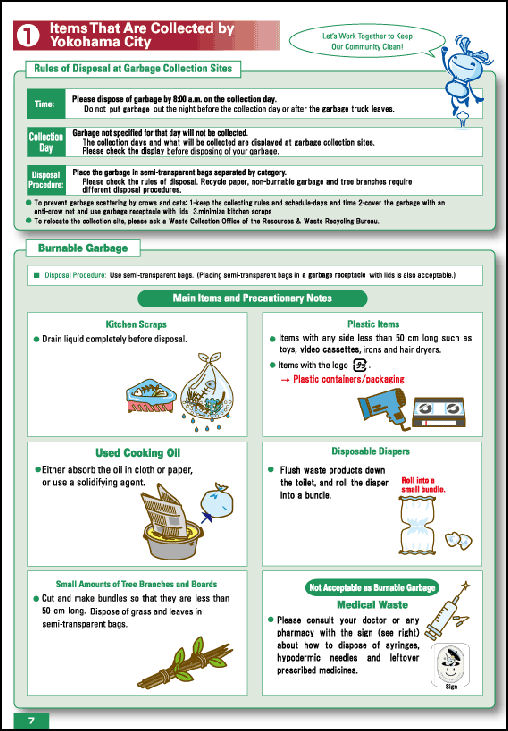
Recycling Food in Japan
Japan disposes of about 20 million tons of food waste a year, five times the amount that was given as food aide to the world’s poor in 2007. In addition to being a waste of food the food also take up landfill space and decomposes producing methane, a greenhouse gas, or is incinerated.
Households are responsible for half of the food waste. By one estimate 6,000 tons of food is thrown away in Tokyo by restaurants and other commercial operations every day.
With prices for animal feed and fertilizers reaching record highs in 2008, there was greater demand for food pellets for pigs and poultry made from recycled leftovers. Recycled feed is about 50 percent cheaper than regular feed. In the past farmer had been reluctant to use but higher regular food prices have caused them to think again. As of 2008, still only 1 percent of feedstock came from recycled food.
Food recyclers tend to use leftovers from convenience stores and restaurants, where strict health laws require food to be thrown after one day. Food from households is not used because the food is often in bad condition. The government is trying to encourage retailers and restaurants — which produce 11 million metric tons a of food waste a year and often pay hefty fees to have food waster hailed away — to work close with feed-recycling companies.
Recycle food taken to a plant is first sorted to remove skewers plastic trays and plastic wrap. The food waste is turned into two kinds of dry feed — one rich in fat and protein and another that is mostly carbohydrates after a final heating process — and a liquid type of feed made from pasteurized drinks and chopped vegetables.
The Japanese food industry recycles 70 percent of its leftovers. About half is made into feed, 5 percent into methane and the rest into fertilizer. Efforts are currently underway to derive energy from recycled food. In an experimental program in Tokyo, ethanol and methane are being made from thrown away school meals.
One effort to make fertilizer from recycled food scraps and animal feed ended in failure because the fertilizer gave off a an "unbearable stench" that farmers and manufacturers couldn't stand.
Itsuo Goto of Tokyo University developed a method for converting organic garbage such as thrown-away vegetables into fertilizer by quickly drying it to reduce odor and increases its effectiveness as fertilizer. Farmers in the Tokyo area have started using fertilizers made from garbage collected from restaurants and households and are happy with the results.

Metal Thieves in Japan
High metal prices in the mid 2000s encouraged thieves to plunder car barriers, chains, electric cables and stainless steel grating used to cover ditches along the sides of streets and sell them as scrap metal. Large temple bells, fire bells, playground slides and metal water storage basins used by farmers were all targeted by metal thieves. Metal thefts in 2006 resulted in losses of over $20 million.
Among the items that were taken were 52 stainless steel car barriers, worth ¥4.6 mullion, stolen from parking lot entrances in Osaka; a 100-kilogram tide gate taken in Ehime Prefecture; 38 fire-lookout-tower bells valued at ¥4.1 million stolen in 12 cities and 1,027 storm grates worth ¥8.4 million taken in Ibaraki Prefecture. Some rail companies hired guards to prevent thieves from taking tracks.
It is suspected that the metal was sold to small scrap metal dealers and then was exported to China. Sometimes the thieves reprocessed the metal into sheets and bricks so it couldn’t be identified or linked to it original source. Sometimes these chores were done by the scrap dealers.
In November 2006, four men were arrested after stealing 275 metal grates worth $50,000 in Osaka. In 2007, more than 150 metal bridge nameplates were stolen from bridges in Fukushima and Tochigi prefectures. Most of the nameplates were 15 centimeters long, 30 centimeters wide and 1.5 centimeters thick and made bronze, They cost between $250 and $350 to make.
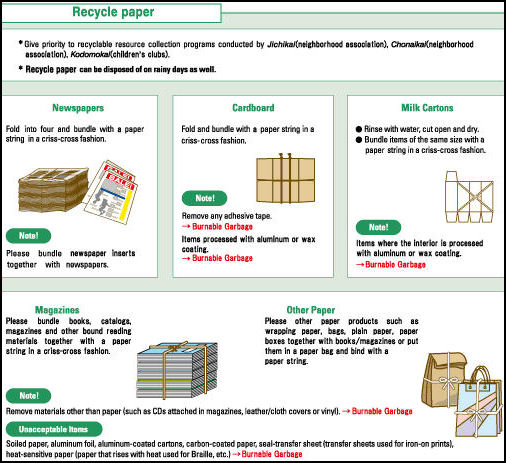
Recycled Paper in Japan In Japan, more than 70 percent of all paper produced is recycled and 60 percent is reprocessed. The government is trying to encourage more recycling of paper packaging of which only 15 percent is recycled.
In January 2008, it was revealed that five major paper companies falsified the ratio of recycled paper on their paper products. The companies — Oji Paper, Hokuetsu Paper, Mitsubishi Paper, Nippon Paper and Daio Paper’said there products contained more recycled paper than they actually did to give the impression the companies were more environmentally-minded than they actually were and to meet new laws that require government offices to buy products that have high levels of recycled paper. In some cases products were labeled as having 40 percent recycled paper when they only had 1 percent.
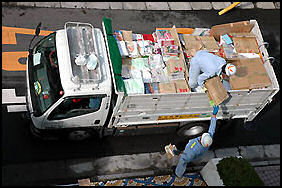
paper recycling truck Much of Japan’s paper is recycled by independent used-paper collectors who roam around in trucks and pick up stacks of recycled newspapers and other paper products in the backs of their trucks. As the value of recycled paper has risen a number of local government have begun cracking down on paper collectors because they paper they pick is supposed to be collected by local government collectors, depriving these local government of funds.
In Shinagawa ward in Tokyo, government cars patrol the streets looking for paper collectors, who if caught are given warnings or tickets with fines of to $500. Many collectors escape into neighboring wards when a patrol gives chase. In Setagaya Ward in Tokyo one recycler was charged with stealing newspaper and fined ¥200,000.
Up until the 1990s most recycled paper was collected by independent collectors but many of these went out of business following a drop in cardboard box production after the economic slump in the 1990s. At that time local government stepped in to do the task. In the 2000s, demand for paper in China caused the price of used paper to soar , bringing about a rapid rise in the number of recylers,
Recycled Televisions and Refrigerators in Japan

New laws went into effect in April 2001 that required home appliances, namely air conditioners, refrigerators, televisions and washing machines to recycled. In 2002 laws were added that require home computers and building industry waste to be recycled. In the future automobiles must also be recycled.
About 18 million air conditioners, refrigerators, televisions and washing machines are disposed of every year in Japan. They account for only 1.3 percent of all the refuge produced but they take up a lot of space and are difficult to break down.
Under the 2001 laws owners of large appliances bear the responsibility and expense of transporting items to a recycling center. They usually do this with a fee paid to the retailers who sells them replacements. Manufacturers are obliged to recycle their products and they of course pass the expenses to the consumers. This approach was adopted rather than levying taxes from consumers or manufacturers to cover the costs. The new laws have led to an increase of illegal dumping.
Large manufacturer require customer to pay an extra ¥2,400 for a washing machine, ¥2,700 for a television, ¥3,500 for an air conditioners and ¥4,600 for refrigerator to cover recycling costs. Customers end up paying about $35 for a washing machine, $40 for a television, $50 for an air conditioners and $60 for refrigerator when the transportation costs are factored in.
The work done at the recycling centers remains labor extensive. Great care must be taken removing Freon containers in the air conditioners and refrigerators to make sure no ozone-depleting gases are not released into the atmosphere. Care also has to be taken with televisions that contain lead and other harmful substances and mattresses with box-springs that can bring a crusher machine to a halt by coiling around the hammers.
Once the appliances are removed of their reusable parts they are put on a conveyor belt that drops them into a crusher that breaks the product down into three inch pieces of metal. These are then separated and graded by a series of or magnets, blowers, filters and spinners.
Large manufacturers like Mitsubishi are now designing their products to be easier to recycle by using stand-size bolts in easy-to-get-at places that can easily be removed using standard tools. Some even have special symbols that explain the best way to dismantle a product.
In December 2008, flat-screen televisions and clothes driers added to the mandatory recycling list
Eco-Technology in Japan
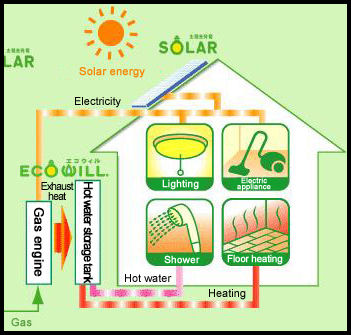
Japan is a leader in eco-technology. Carbon fiber parts made in Japan make automobiles and aircraft lighter and more fuel efficient. Advanced cleaning technology for coal plants reduces air pollution.
Japanese companies are introducing recycling methods and, water- and air-cleaning technologic to China. Fuji Xerox has built a $6 million factory that collects used copy machines, printers and ink cartridges and exacts 64 materials form them, including steel, aluminum and glass. Guangzhou Honda’s second factory in Guangdong Province is outfit with the latest zero emission technologies, which includes a water treatment plant that treats all water so that it is clean before it is discharged. Matsushita used similar technologies at a plant that makes cathode ray tubes.
Japan is a leader in clean coal technology such as IGCC (integrated gasification combined cycle), in which coal is turned into gas to remove impurities before combustion; and IGFC (integrated gasification fuel combined cycle), in which gasified coal achieves high power generation efficiency with a triple system of fuel cells. gas turbines and steam turbine. These systems are still largely experiential at this stage yet Japan is introducing the technology to China, India and other countries.
See Automobiles
See New Technology and Reducing Carbon Dioxide, Global Warming
Japanese Green Innovation
On Japan as a global green innovator Nathan Gardels, editor-in-chief of NPQ and the Global Viewpoint Network, wrote: “While the world has been focused on Islamist terrorism or the miracle of Chinese growth, the island nation has been engaging in a quiet revolution as the incubator of the energy-efficient technologies of the future. Japan is responsible for 50 percent of the world's solar-power energy production. It uses 20 percent less energy to produce a ton of steel than the U.S., 50 percent less than China. [Source: Nathan Gardels, Global Viewpoint, March 14 2011]
“Innovations abound, from capturing "ice energy," to more energy-efficient plasma screens, to capturing the kinetic energy of bridges that sway when traffic crosses them. The facility that housed the media at the Lake Toya G-8 summit in 2008 was cooled by snow stored in thermal insulation instead of by air conditioning. As everyone knows, Japan is the leading manufacturer and exporter of hybrid cars, most famously the Toyota Prius. Honda has developed a hydrogen fuel cell car that is being prepared for mass production. Komatsu has just produced the world's first-ever hybrid heavy machinery, a 20-ton excavator used in construction sites all across Asia.”
“Beneath the surface of Japan's faddish consumer society, the frugal culture of an island nation that must wisely husband limited resources still lives. This cultural disposition that has been the fertile soil for the development of green technology will only be bolstered by the earthquake and tsunami damage to Japan's nuclear reactors, as well as the economic jolt of rising oil prices resulting from the combined effects of the sudden drop in refining capacity because of Japan's damaged facilities and...the Arab revolt.”
In recent years, Tokyo has taken a number of steps to become the greenest city in the world. It has 1) beefed up environmental building standards, requiring factories and office buildings to reduce carbon emissions by 25 percent from 2000 by 2010; 2) provided cash incentives for people to install solar panels at their homes and banned old diesel trucks from the city’s streets; 3) called for the planting or a half million trees and creating rooftop gardens; 4) produced development where large scale recycling, greenery, rainwater re-use and waste water recapture are all standard features; and 4) converted a 217-acre landfill in Tokyo Bay into a “sea forest” and park.
Tokyo Waterfront Recycle Power Co. runs a cutting edge waste disposal plant on a man-made island in Tokyo Bay, where garbage is brought in by trucks and recycled. What can’t be recycled is burned and filtered, with minimal emissions and requiring no land fill space. The heat produced is enough to provide electricity for 55,000 homes. Food waste is turned into animal feed. A special system filters out and treats PCBs. What is more is that after all this Tokyo Waterfront makes a profit.
High-Absorption Rice-Husk Charcoal and Dishes Made of Bamboo and Corn Resin
A team of researchers has developed new technology to make activated charcoal with high-level absorption capability from rice husks. The team, from Nagaoka University of Technology in Nagaoka, Niigata Prefecture, said the rice husk-derived charcoal has a wide variety of applications, such as reducing carbon dioxide and other greenhouse gas emissions, and as material for fuel cells that can absorb large quantities of hydrogen. [Source: Yomiuri Shimbun, February 19, 2011]
The Yomiuri Shimbun reported: “When rice husks are heated to form charcoal, silicon dioxide remains as a by-product and obstructs the charcoal's absorption function. The research team was able to neutralize the silicon dioxide by reheating the charcoal after mixing in potassium hydrate or sodium hydrate. Afterward, the charcoal surface had a countless number of 1.1-nanometer diameter holes. One nanometer is one billionth of a meter. The holes expand the charcoal's surface area and imbue the material with high absorption capability. The average surface area of conventional activated charcoal is 1,000 square meters per gram, but the figure of the newly developed charcoal is 2.5 times that.”
Fuse Technonet Co., a semiconductor device manufacturer based in Hachioji, western Tokyo, has cooperated in a joint development study with the university team. The company sees the rice husk charcoal as a promising material for the manufacture of battery electrical poles, and is trying to develop the technology to mass-produce it as quickly as possible. "Rice husks can be procured in huge quantities from any part of the nation. We don't consider this merely as a way to utilize agricultural waste but as a new kind of industrial material," a company spokesman said.
Iwamoto Corp. is a a small Osaka company whose motto is: "Manufacture goods friendly to the environment," It has successfully developed a range of plasticlike containers, including tea cups, bowls and trays, using only bamboo fibers and corn-extracted resins, designed to serve lunches at schools, kindergartens, nurseries and elsewhere. "We've developed these goods aiming to make better use of bamboo groves that've been left untended," Kazunori Iwamoto, president of the company, told the Yomiuri Shimbun. "Our containers keep well, are heat-resistant and well suited to hold children's lunches." [Source: Yomiuri Shimbun , November 22, 2010]
According to the Agriculture, Forestry and Fisheries Ministry's Forestry Agency, bamboo groves are estimated at 159,000 hectares in area nationwide. Those used for commercial purposes, such as the production of bamboo sprouts and construction materials, comprise only 30 percent to 40 percent of the total, the agency said. In the past, bamboo was used for a variety of purposes including the manufacture of farm tools, fences, interior decorating and other items. However, bamboo consumption continued to dwindle due to changes in lifestyles over the past few decades, leading to an increase in abandoned bamboo groves. Bamboo groves, if left untended, grow excessively large, to the extent of blocking sunlight from reaching the ground, hampering other plant growth.
Image Sources: 1) 3) Ray Kinnane 2) Japan Visitors 4) Doug Mann Photomann 5) 6) 7) 8) Yokohama City, 9) Osaka Gas, 10) 11) Greenpeace, trucks and collectors, Japan Photo japan-photo.de ;
Text Sources: New York Times, Washington Post, Los Angeles Times, Daily Yomiuri, Times of London, Japan National Tourist Organization (JNTO), National Geographic, The New Yorker, Time, Newsweek, Reuters, AP, Lonely Planet Guides, Compton’s Encyclopedia and various books and other publications.
Last updated October 2012
